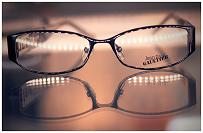Home > about eyes > Presbyopia
Presbyopia
Presbyopia is a condition where the eye exhibits a progressively diminished ability to focus on near objects with age. Presbyopia’s exact mechanisms are not known with certainty; the research evidence most strongly supports a loss of elasticity of the crystalline lens, although changes in the lens’s curvature from continual growth and loss of power of the ciliary muscles (the muscles that bend and straighten the lens) have also been postulated as its cause. Like gray hair and wrinkles, presbyopia is a symptom caused by the natural course of aging.
|
 "...Like gray hair and wrinkles, presbyopia is a symptom caused by the natural course of aging." |
More noticeable in low light:
Presbyopia symptoms, like other focus defects, become much less noticeable in bright sunlight due to the action of the iris closing to a smaller diameter. As with any lens, increasing the focal ratio of the lens increases depth of field by reducing the level of blur of out-of-focus objects (compare the effect of aperture on depth of field in photography).
A delayed onset of seeking correction for presbyopia has been found among those with certain professions and those with miotic pupils. In particular, farmers and homemakers seek correction later, whereas service workers and construction workers seek eyesight correction earlier, as do those who do a lot of computer work. It is also more noticeable earlier on for those with hyperopia.
A delayed onset of seeking correction for presbyopia has been found among those with certain professions and those with miotic pupils. In particular, farmers and homemakers seek correction later, whereas service workers and construction workers seek eyesight correction earlier, as do those who do a lot of computer work. It is also more noticeable earlier on for those with hyperopia.
Many people with myopia (near-sightedness) can read comfortably without eyeglasses or contact lenses even after the age of 40. However, their myopia does not disappear and the long-distance visual challenges remain. Myopes considering refractive surgery are advised that surgically correcting their nearsightedness may be a disadvantage after age 40, when the eyes become presbyopic and lose their ability to accommodate or change focus because they will then need to use glasses for reading.
Myopes with astigmatism find near vision better, though not perfect, without glasses or contact lenses when presbyopia sets in, but the more astigmatism the poorer their uncorrected near vision.
Presbyobia is typically corrected with a pair of bi-focal, progressive or multi-focal glasses. These will simultaneously correct any astigmatism as well as offering an extension on your eye's focal range (from near to far). In earlier stages, a patient may only require single vision glasses (eg. for reading up close).
Myopes with astigmatism find near vision better, though not perfect, without glasses or contact lenses when presbyopia sets in, but the more astigmatism the poorer their uncorrected near vision.
Presbyobia is typically corrected with a pair of bi-focal, progressive or multi-focal glasses. These will simultaneously correct any astigmatism as well as offering an extension on your eye's focal range (from near to far). In earlier stages, a patient may only require single vision glasses (eg. for reading up close).
If you think you may be experiencing these symptoms, (especially if you are in the 40ish age group) it would be prudent to drop in and have us sort it out for you. Unfortunately, it is not likely to go away by itself, but the good news is that it is fairly easy to extend the usefulness of your eyes with a vision correction solution (ie. time for a pair of glasses!). |
 |



